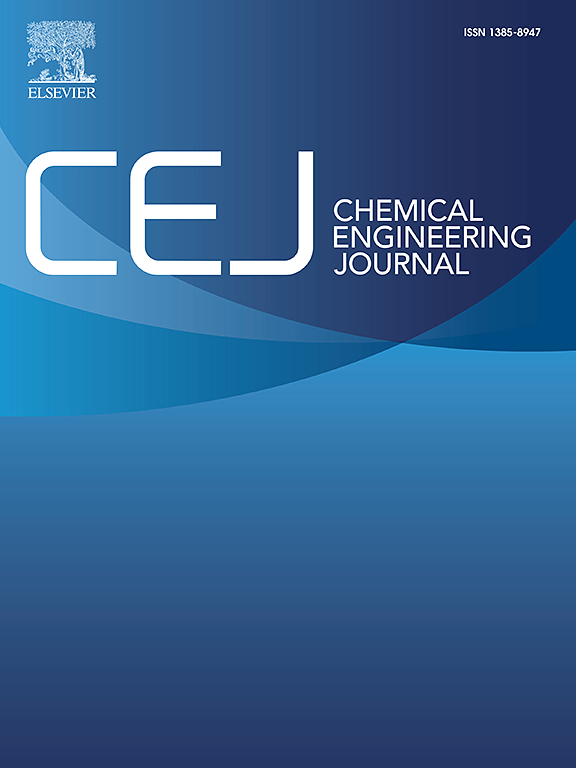Spermidine-based carbon quantum dots nanocomposite hydrogel films enhance bone healing via type H angiogenesis and HMGA2-dependent PI3K/AKT/eNOS signaling pathway
IF 13.3
1区 工程技术
Q1 ENGINEERING, CHEMICAL
引用次数: 0
Abstract
Background and method
Incidence of multifactorial fractures and non-unions is increasing. Enhancing fracture vascularization, particularly through the proliferation of H-type blood vessels, can effectively accelerate bone repair. A novel class of ST-CQDs synthesized from spermidine trihydrochloride was developed to enhance angiogenesis in vitro and in vivo. Functional analysis, Western blotting, qRT-PCR, and RNA transcriptomics identified signaling pathways involved in HMEC-1 cell proliferation and tube formation. The ST-CQDs were incorporated into GelMA and tested in a murine fracture model. Radiological, mechanical, and histological analyses confirmed that ST-CQDs@GM promoted H-type vessel formation and enhanced bone repair.Results
ST-CQDs were synthesized using a combination of calcination, ultrasonication, and centrifugation. The nanoscale morphology and crystalline structure of the ST-CQDs were confirmed by HR-TEM and XRD analyses, while UV–Vis, Raman, FTIR, and XPS techniques were utilized for further physicochemical characterization. Co-treatment with L-NAME demonstrated that ST-CQDs significantly elevated the p-eNOS to total eNOS ratio and enhanced NO release in HMEC-1 cells. RNA profiling revealed HMGA2 as a key regulatory target, and subsequent siRNA knockdown experiments confirmed that ST-CQDs upregulated HMGA2 expression, activated the PI3K/AKT/eNOS signaling pathway, and promoted the expression of SLIT3 and HIF-1α. Following verification of their stability and biocompatibility, ST-CQDs@GM were shown to significantly improve fracture healing and vascularization in a murine model, primarily through the HMGA2-mediated activation of the PI3K/AKT/eNOS pathway, which facilitated the formation of H-type blood vessels.Conclusion
Our study introduces a novel therapeutic strategy for bone regeneration using ST-CQDs@GM. This formulation demonstrates excellent biocompatibility, modulates angiogenesis via the HMGA2/PI3K/AKT/eNOS signaling axis, promotes the formation of H-type blood vessels, and enhances fracture healing. These findings underscore its promising translational potential in the treatment of delayed and non-union fractures.

亚精胺基碳量子点纳米复合水凝胶膜通过H型血管生成和hmga2依赖性PI3K/AKT/eNOS信号通路促进骨愈合
背景与方法多因素骨折和骨不连的发病率正在上升。加强骨折血管化,特别是通过h型血管的增殖,可以有效地加速骨修复。以三盐酸亚精胺为原料合成了一类促进体外和体内血管生成的ST-CQDs。功能分析、Western blotting、qRT-PCR和RNA转录组学鉴定了参与HMEC-1细胞增殖和管形成的信号通路。将ST-CQDs纳入GelMA并在小鼠骨折模型中进行测试。放射学、力学和组织学分析证实ST-CQDs@GM促进h型血管形成和增强骨修复。结果采用煅烧、超声和离心相结合的方法合成了st - cqds。通过HR-TEM和XRD分析证实了ST-CQDs的纳米形貌和晶体结构,并利用UV-Vis、Raman、FTIR和XPS技术对其进行了进一步的物理化学表征。与L-NAME共处理表明,ST-CQDs显著提高了HMEC-1细胞中p-eNOS与总eNOS的比率,并增强了NO的释放。RNA分析显示HMGA2是关键的调控靶点,随后的siRNA敲低实验证实ST-CQDs上调HMGA2的表达,激活PI3K/AKT/eNOS信号通路,促进SLIT3和HIF-1α的表达。通过对其稳定性和生物相容性的验证,ST-CQDs@GM在小鼠模型中被证明可以显著改善骨折愈合和血管形成,主要是通过hmga2介导的PI3K/AKT/eNOS通路的激活,促进h型血管的形成。结论本研究提出了一种利用ST-CQDs@GM进行骨再生的新治疗策略。该制剂具有良好的生物相容性,通过HMGA2/PI3K/AKT/eNOS信号轴调节血管生成,促进h型血管的形成,促进骨折愈合。这些发现强调了其在治疗迟发性和不愈合骨折方面有希望的转化潜力。
本文章由计算机程序翻译,如有差异,请以英文原文为准。
求助全文
约1分钟内获得全文
求助全文
来源期刊

Chemical Engineering Journal
工程技术-工程:化工
CiteScore
21.70
自引率
9.30%
发文量
6781
审稿时长
2.4 months
期刊介绍:
The Chemical Engineering Journal is an international research journal that invites contributions of original and novel fundamental research. It aims to provide an international platform for presenting original fundamental research, interpretative reviews, and discussions on new developments in chemical engineering. The journal welcomes papers that describe novel theory and its practical application, as well as those that demonstrate the transfer of techniques from other disciplines. It also welcomes reports on carefully conducted experimental work that is soundly interpreted. The main focus of the journal is on original and rigorous research results that have broad significance. The Catalysis section within the Chemical Engineering Journal focuses specifically on Experimental and Theoretical studies in the fields of heterogeneous catalysis, molecular catalysis, and biocatalysis. These studies have industrial impact on various sectors such as chemicals, energy, materials, foods, healthcare, and environmental protection.
 求助内容:
求助内容: 应助结果提醒方式:
应助结果提醒方式:


